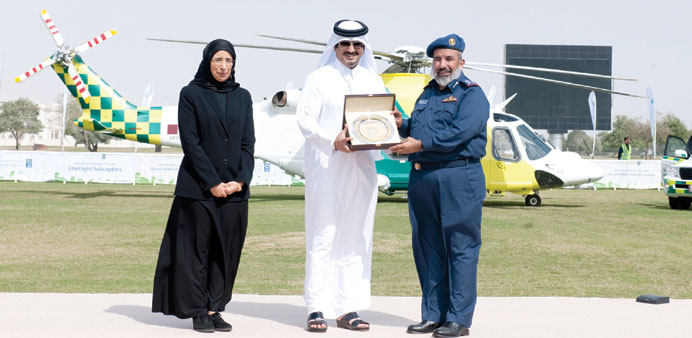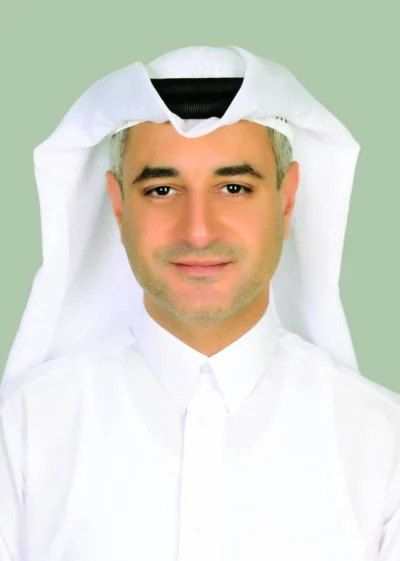HE al-Qahtani presenting a plaque of appreciation to a senior official while Dr al-Kuwari look on. One of the newly-launched LifeFlight helicopters is in the background
By Noimot Olayiwola
Staff Reporter
|
|
The air ambulance service at the Hamad Medical Corporation (HMC) yesterday received a boost with three new helicopters joining its LifeFlight operations.
A ceremony to mark the occasion was held in the presence of HE the Minister of Public Health Abdullah bin Khalid al-Qahtani, Army Headquarters chief of staff Major General Ghanim bin Shaheen al-Ghanim and HMC managing director Dr Hanan al-Kuwari.
The introduction of the new Agusta Westland AW139 LifeFlight helicopters will increase access to safe and effective emergency healthcare while ensuring air ambulance coverage even in the remotest areas of the country.
Two of the new helicopters, which will be in operation round-the-clock, replace smaller ones previously in use. The third helicopter will be on standby as a back-up for the two in service.
The new helicopters are being primarily used to transport seriously injured persons as quickly as possible from the scene of an emergency to hospital.
The helicopters are fitted with the most up-to-date medical equipment such as the LUCAS II chest compression device to enable chest compressions to continue for a patient while in transit.
According to Ambulance Service chief executive officer Dr Robert Owen, the new helicopters are larger and roomier than the old ones.
“These are pretty larger than the previous helicopters and can take two patients, treat them simultaneously and both patients have equipment as same as in the intensive care unit.”
The official said that during flight, patients could be monitored while defibrillator and infusion could also be done.
“The aircraft themselves are an excellent platform for air ambulance as they are very powerful and extremely fast. They have vibration dampening system in place, as helicopters make lot of vibrations while flying but the aircraft are largely soundproof,” the official said.
“Two pilots control each helicopter. On board the helicopter is a critical care flight paramedic and flight ambulance paramedic at all times to administer emergency medical care both at the scene of the incident and on flight to hospital. These are the most advanced air ambulances that you can find anywhere in the world,” the official said.
The pilots of the helicopters are from the Qatar Emiri Air Force (QEAF) and the launch of the air ambulances signified a new working relationship between HMC and QEAF.
“Because the ambulance are really sophisticated and fitted with advanced technology they will be based in Al Udeid Air Force base in order to get access to engineering maintenance that they will need,” Dr Owen said.
The air ambulance service is mainly for the Sealine area, Al Khor and other rural areas as well as abroad including Saudi Arabia and the UAE.
The helicopters complement a diverse fleet that has been planned and put together with Qatar’s specific needs in mind.
“These helicopters are an essential element of the fleet and they are most appropriate in cases where speed is of the essence. Of course this isn’t always the case, and the helicopter is not always the most appropriate transport to the hospital, but they are extremely necessary to the overall fleet and play an integral part in the HMC Ambulance Service, providing access to the safest and most effective care for the people of Qatar,” Dr Owen added.
Ambulance Service deputy medical director Dr Ibrahim M Fawzy Hassan pointed out that the helicopters could get emergency medical teams to the scene of a serious incident quickly.
“At the ambulance service, we are always looking for ways to get the best clinical care to patients as quickly as possible. This is how we can improve mortality rates and provide the people of Qatar with a top quality service. The launch of these LifeFlight helicopters marks a very important addition to the service and one that will greatly benefit our patients.”
Other vehicles include the fully equipped Mercedes Benz Sprinter ambulances, with a streamlined shape designed to cut through the Qatar traffic and the Toyota Landcruiser GX’s that enable paramedics to access patients in the desert.
There are presently now some 48 spokes and six hubs for easy ambulance distribution across Qatar.



